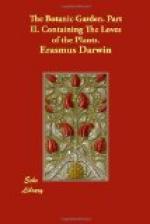Veil’d,
with gay decency and modest pride,
310 Slow to the mosque she moves, an eastern bride;
There
her soft vows unceasing love record,
Queen
of the bright seraglio of her Lord.—
So
sinks or rises with the changeful hour
The
liquid silver in its glassy tower.
315 So turns the needle to the pole it loves,
With
fine librations quivering as it moves.
All
wan and shivering in the leafless glade
The
sad ANEMONE reclined her head;
Grief
on her cheeks had paled the roseate hue,
320 And her sweet eye-lids dropp’d with pearly
dew.
—“See,
from bright regions, borne on odorous gales
The
Swallow, herald of the summer, sails;
[Anemone. l. 318. Many males, many females. Pliny says this flower never opens its petals but when the wind blows; whence its name: it has properly no calix, but two or three sets of petals, three in each set, which are folded over the stamens and pistil in a singular and beautiful manner, and differs also from ranunculus in not having a melliferous pore on the claw of each petal. ]
[The Swallow. l. 322. There is a wonderful conformity between the vegetation of some plants, and the arrival of certain birds of passage. Linneus observes that the wood anemone blows in Sweden on the arrival of the swallow; and the marsh mary-gold, Caltha, when the cuckoo sings. Near the same coincidence was observed in England by Stillingfleet. The word Coccux in Greek signifies both a young fig and a cuckoo, which is supposed to have arisen from the coincidence of their appearance in Greece. Perhaps a similar coincidence of appearance in some parts of Asia gave occasion to the story of the loves of the rose and nightingale, so much celebrated by the eastern poets. See Dianthus. The times however of the appearance of vegetables in the spring seem occasionally to be influenced by their acquired




